英语中的修辞格figure of speech
- 格式:doc
- 大小:94.50 KB
- 文档页数:9
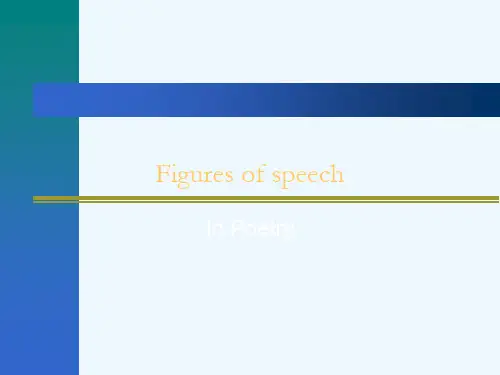
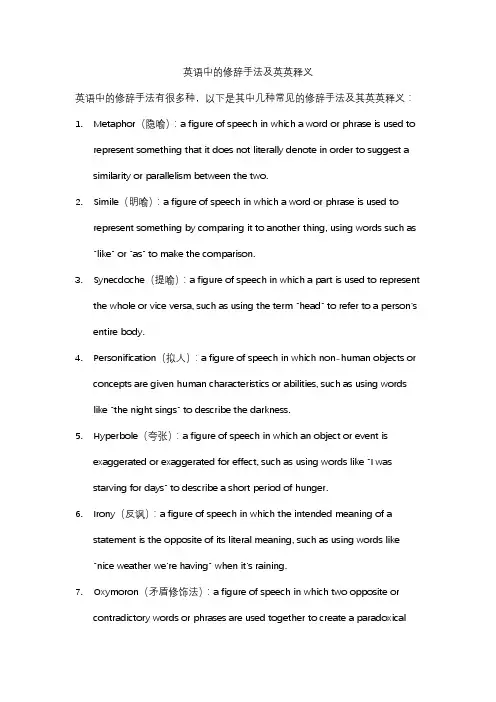
英语中的修辞手法及英英释义英语中的修辞手法有很多种,以下是其中几种常见的修辞手法及其英英释义:1.Metaphor(隐喻):a figure of speech in which a word or phrase is used torepresent something that it does not literally denote in order to suggest a similarity or parallelism between the two.2.Simile(明喻):a figure of speech in which a word or phrase is used torepresent something by comparing it to another thing, using words such as "like" or "as" to make the comparison.3.Synecdoche(提喻):a figure of speech in which a part is used to representthe whole or vice versa, such as using the term "head" to refer to a person's entire body.4.Personification(拟人):a figure of speech in which non-human objects orconcepts are given human characteristics or abilities, such as using words like "the night sings" to describe the darkness.5.Hyperbole(夸张):a figure of speech in which an object or event isexaggerated or exaggerated for effect, such as using words like "I wasstarving for days" to describe a short period of hunger.6.Irony(反讽):a figure of speech in which the intended meaning of astatement is the opposite of its literal meaning, such as using words like"nice weather we're having" when it's raining.7.Oxymoron(矛盾修饰法):a figure of speech in which two opposite orcontradictory words or phrases are used together to create a paradoxicaleffect, such as using words like "bittersweet" to describe a mixed feeling of happiness and sadness.这些修辞手法都可以增强语言的表达力,帮助传达更深刻的意义。
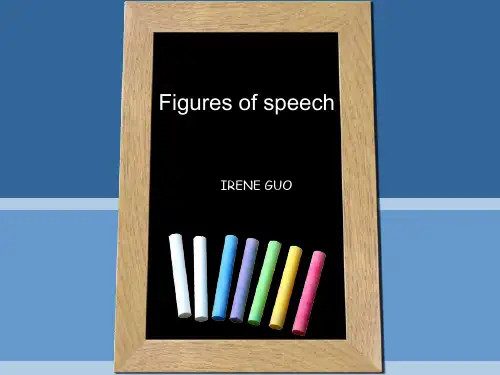
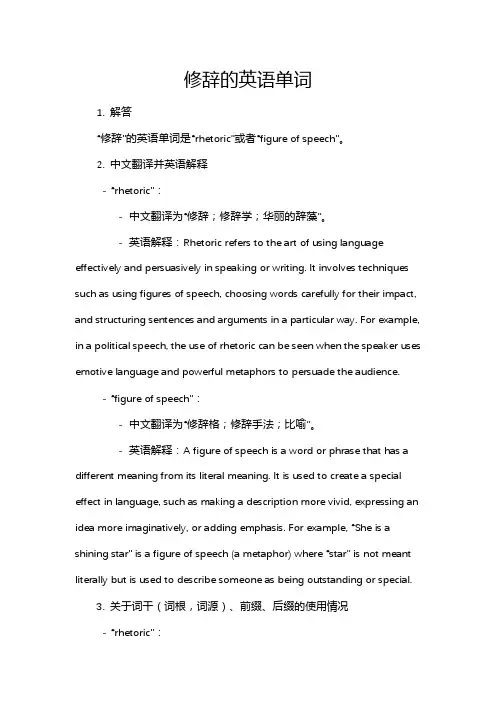
修辞的英语单词1. 解答“修辞”的英语单词是“rhetoric”或者“figure of speech”。
2. 中文翻译并英语解释- “rhetoric”:- 中文翻译为“修辞;修辞学;华丽的辞藻”。
- 英语解释:Rhetoric refers to the art of using language effectively and persuasively in speaking or writing. It involves techniques such as using figures of speech, choosing words carefully for their impact, and structuring sentences and arguments in a particular way. For example, in a political speech, the use of rhetoric can be seen when the speaker uses emotive language and powerful metaphors to persuade the audience.- “figure of speech”:- 中文翻译为“修辞格;修辞手法;比喻”。
- 英语解释:A figure of speech is a word or phrase that has a different meaning from its literal meaning. It is used to create a special effect in language, such as making a description more vivid, expressing an idea more imaginatively, or adding emphasis. For example, “She is a shining star” is a figure of speech (a metaphor) where “star” is not meant literally but is used to describe someone as being outstanding or special.3. 关于词干(词根,词源)、前缀、后缀的使用情况- “rhetoric”:- 词源:它源自于希腊语“rhetorike”,表示“演讲的艺术”。
![英语修辞手法figuresofspeech[文字可编辑]](https://uimg.taocdn.com/f03e3e5ece2f0066f53322c7.webp)
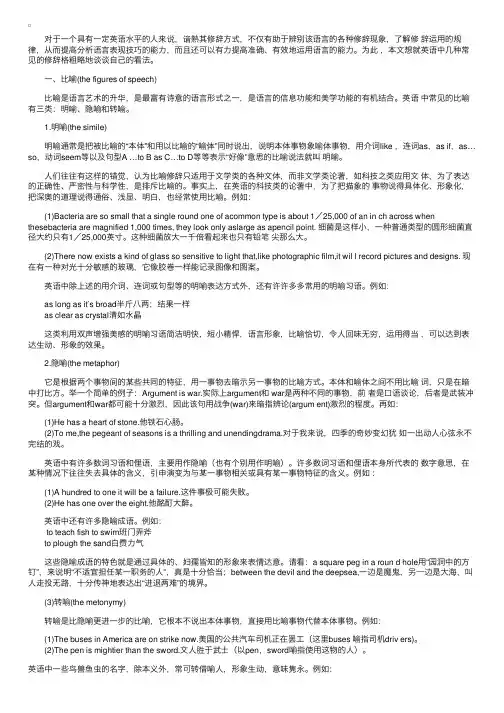
对于⼀个具有⼀定英语⽔平的⼈来说,谙熟其修辞⽅式,不仅有助于辨别该语⾔的各种修辞现象,了解修辞运⽤的规律,从⽽提⾼分析语⾔表现技巧的能⼒,⽽且还可以有⼒提⾼准确、有效地运⽤语⾔的能⼒。
为此,本⽂想就英语中⼏种常见的修辞格粗略地谈谈⾃⼰的看法。
⼀、⽐喻(the figures of speech) ⽐喻是语⾔艺术的升华,是最富有诗意的语⾔形式之⼀,是语⾔的信息功能和美学功能的有机结合。
英语中常见的⽐喻有三类:明喻、隐喻和转喻。
1.明喻(the simile) 明喻通常是把被⽐喻的“本体”和⽤以⽐喻的“喻体”同时说出,说明本体事物象喻体事物,⽤介词like ,连词as,as if,as…so,动词seem等以及句型A …to B as C…to D等等表⽰“好像”意思的⽐喻说法就叫明喻。
⼈们往往有这样的错觉,认为⽐喻修辞只适⽤于⽂学类的各种⽂体,⽽⾮⽂学类论著,如科技之类应⽤⽂体,为了表达的正确性、严密性与科学性,是排斥⽐喻的。
事实上,在英语的科技类的论著中,为了把描象的事物说得具体化、形象化,把深奥的道理说得通俗、浅显、明⽩,也经常使⽤⽐喻。
例如: (1)Bacteria are so small that a single round one of acommon type is about 1/25,000 of an in ch across when thesebacteria are magnified 1,000 times, they look only aslarge as apencil point. 细菌是这样⼩,⼀种普通类型的圆形细菌直径⼤约只有1/25,000英⼨。
这种细菌放⼤⼀千倍看起来也只有铅笔尖那么⼤。
(2)There now exists a kind of glass so sensitive to light that,like photographic film,it wil l record pictures and designs. 现在有⼀种对光⼗分敏感的玻璃,它像胶卷⼀样能记录图像和图案。
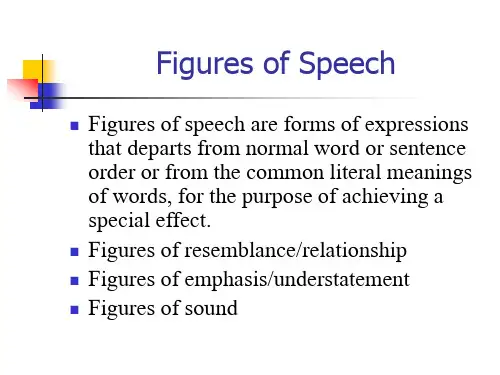
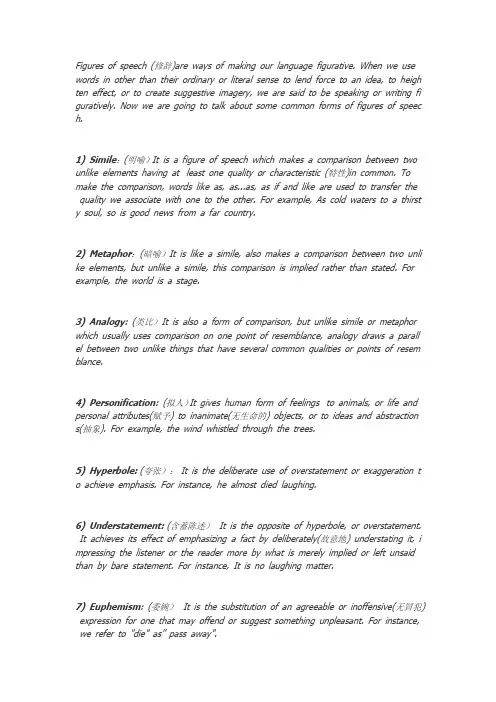
Figures of speech (修辞)are ways of making our language figurative. When we use words in other than their ordinary or literal sense to lend force to an idea, to heigh ten effect, or to create suggestive imagery, we are said to be speaking or writing fi guratively. Now we are going to talk about some common forms of figures of speec h.1) Simile:(明喻)It is a figure of speech which makes a comparison between two unlike elements having at least one quality or characteristic (特性)in common. To make the comparison, words like as, as...as, as if and like are used to transfer the quality we associate with one to the other. For example, As cold waters to a thirst y soul, so is good news from a far country.2) Metaphor:(暗喻)It is like a simile, also makes a comparison between two unli ke elements, but unlike a simile, this comparison is implied rather than stated. For example, the world is a stage.3) Analogy: (类比)It is also a form of comparison, but unlike simile or metaphor which usually uses comparison on one point of resemblance, analogy draws a parall el between two unlike things that have several common qualities or points of resem blance.4) Personification: (拟人)It gives human form of feelings to animals, or life and personal attributes(赋予) to inanimate(无生命的) objects, or to ideas and abstraction s(抽象). For example, the wind whistled through the trees.5) Hyperbole: (夸张): It is the deliberate use of overstatement or exaggeration t o achieve emphasis. For instance, he almost died laughing.6) Understatement: (含蓄陈述)It is the opposite of hyperbole, or overstatement. It achieves its effect of emphasizing a fact by deliberately(故意地) understating it, i mpressing the listener or the reader more by what is merely implied or left unsaid than by bare statement. For instance, It is no laughing matter.7) Euphemism: (委婉)It is the substitution of an agreeable or inoffensive(无冒犯) expression for one that may offend or suggest something unpleasant. For instance, we refer to "die" as” pass away".8) Metonymy (转喻)It is a figure of speech that has to do with the substitution of the mane of one thing for that of another. For instance, the pen (words) is mi ghtier than the sword (forces).9) Synecdoche (提喻)It is involves the substitution of the part for the whole, or the whole for the part. For instance, they say there's bread and work for all. She was dressed in silks.10) Antonomasia (换喻)It has also to do with substitution. It is not often mentio ned now, though it is still in frequent use. For example, Solomon for a wise man. Daniel for a wise and fair judge. Judas for a traitor.11) Pun: (双关语)It is a play on words, or rather a play on the form and meani ng of words. For instance, a cannon-ball took off his legs, so he laid down his arm s. (Here "arms" has two meanings: a person's body; weapons carried by a soldier.)12) Solipsism: (一语双叙)It has two connotations. In the first case, it is a figure by which a word, or a particular form or inflection of a word, refers to two or m ore words in the same sentence, while properly applying to or agreeing with only o n of them in grammar or syntax(句法). For example, He addressed you and me, an d desired us to follow him. (Here we are used to refer to you and me.)In the second case, it a word may refer to two or more words in the same sente nce. For example, while he was fighting, and losing limb and mind, and dying, othe rs stayed behind to pursue education and career. (Here to losing one's limbs in liter al; to lose one's mind is figurative, and means to go mad.)13) Zeugma: (轭式搭配)It is a single word which is made to modify or to gover n two or more words in the same sentence, wither properly applying in sense to o nly one of them, or applying to them in different senses. For example, the sun shal l not burn you by day or the moon by night. (Here noon is not strong enough to burn)14) Irony: (反语)It is a figure of speech that achieves emphasis by saying the opposite of what is meant, the intended meaning of the words being the opposite of their usual sense. For instance, we are lucky, what you said makes me feel realgood.15) Innuendo: (暗讽)It is a mild form of irony, hinting in a rather roundab out (曲折)way at something disparaging(不一致) or uncomplimentary(不赞美) to the person or subject mentioned. For example, the weatherman said it would be worm. He must take his readings in a bathroom.16) Sarcasm: (讽刺)It Sarcasm is a strong form of irony. It attacks in a taunting and bitter manner, and its aim is to disparage, ridicule and wound the feelings of the subject attacked. For example, laws are like cobwebs, which may catch small f lies, but let wasps break through.17) Paradox: (似非而是的隽语)It is a figure of speech consisting of a statement or proposition which on the face of it seems self-contradictory, absurd or contrary t oestablished fact or practice, but which onfurther thinking and study may prove to be true, well-founded, and even to contain a succinct point. For example more hast e, less speed.18) Oxymoron: (矛盾修饰)It is a compressed paradox, formed by the conjoinin g(结合) of two contrasting, contradictory or incongruous(不协调) terms as in bitter-s weet memories, orderly chaos(混乱) and proud humility(侮辱).19) Antithesis: (对照)It is the deliberate arrangement of contrasting words or i deas in balanced structural forms to achieve emphasis. For example, speech is silver; silence is golden.20) Epigram: (警句)It states a simple truth pithily(有利地) and pungently(强烈地). It is usually terse and arouses interest and surprise by its deep insight into certain aspects of human behavior or feeling. For instance, Few, save the poor, feel for the poor.21) Climax: (渐进)It is derived from the Greek word for "ladder" and implies the progression of thought at a uniform or almost uniform rate of significance or inte nsity, like the steps of a ladder ascending evenly. For example, I came, I saw, I co nquered.22) Anti-climax or bathos: (突降) It is the opposite of Climax. It involves stating one's thoughts in a descending order of significance or intensity, from strong to weak, from weighty to light or frivolous. For instance, But thousands die, without or this or that, die, and endow(赋予) a college, or a cat.23) Apostrophe:(顿呼)In this figure of speech, a thing, place, idea or perso n (dead or absent) is addressed as if present, listening and understanding what is being said.For instance, England! awake! awake! awake!24) Transferred Epithet: (转类形容词)It is a figure of speech where an epithet (an adjective or descriptive phrase) is transferred from the noun it should rightly m odify(修饰) to another to which it does not really apply or belong. For instance, I s pent sleepless nights on my project.25) Alliteration: (头韵)It has to do with the sound rather than the sense of wo rds for effect. It is a device that repeats the same sound at frequent intervals(间隔) and since the sound repeated is usually the initial consonant sound, it is also calle d "front rhyme". For instance, the fair breeze blew, the white foam flew, the furrow followed free.26) Onomatopoeia: (拟声)It is a device that uses words which imitate the soun ds made by an object (animate or inanimate), or which are associated with or sug gestive(提示的) of some action or movement。
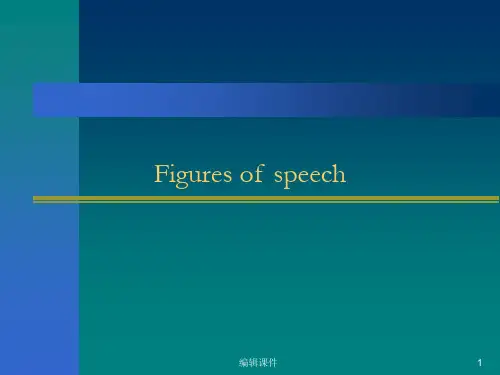
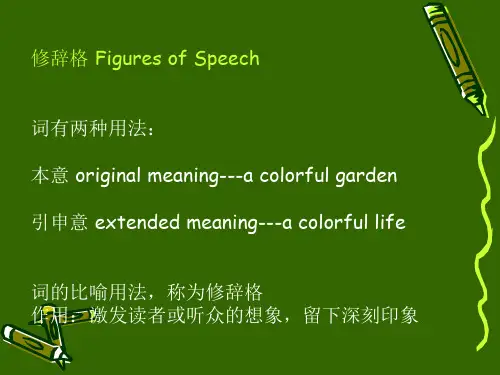
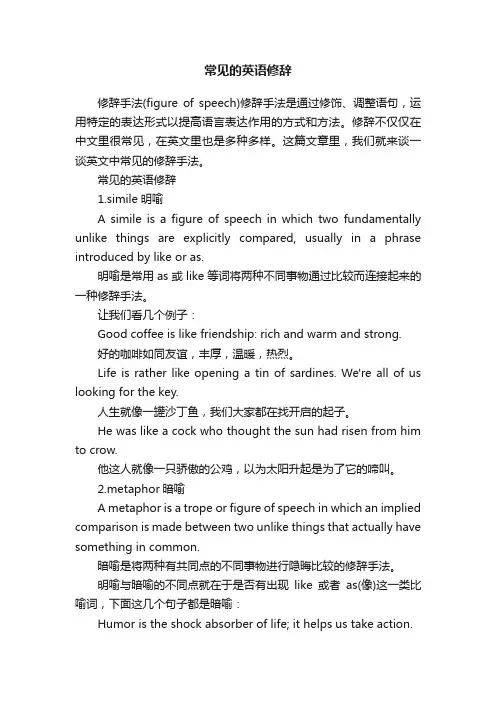
常见的英语修辞修辞手法(figure of speech)修辞手法是通过修饰、调整语句,运用特定的表达形式以提高语言表达作用的方式和方法。
修辞不仅仅在中文里很常见,在英文里也是多种多样。
这篇文章里,我们就来谈一谈英文中常见的修辞手法。
常见的英语修辞1.simile明喻A simile is a figure of speech in which two fundamentally unlike things are explicitly compared, usually in a phrase introduced by like or as.明喻是常用as或like等词将两种不同事物通过比较而连接起来的一种修辞手法。
让我们看几个例子:Good coffee is like friendship: rich and warm and strong.好的咖啡如同友谊,丰厚,温暖,热烈。
Life is rather like opening a tin of sardines. We're all of us looking for the key.人生就像一罐沙丁鱼,我们大家都在找开启的起子。
He was like a cock who thought the sun had risen from him to crow.他这人就像一只骄傲的公鸡,以为太阳升起是为了它的啼叫。
2.metaphor暗喻A metaphor is a trope or figure of speech in which an implied comparison is made between two unlike things that actually have something in common.暗喻是将两种有共同点的不同事物进行隐晦比较的修辞手法。
明喻与暗喻的不同点就在于是否有出现like或者as(像)这一类比喻词,下面这几个句子都是暗喻:Humor is the shock absorber of life; it helps us take action.幽默是生活的减震器,它可以鼓舞人们付诸于行动。
英语修辞figures of speech (中文版),修辞格(figures of speech) 大体分为三类:音韵修辞格(phonological rhetorical devices ) ;词义修辞格(semantic rhetorical devices)和句法修辞格(syntactical rhetorical devices) 。
(一)音韵修辞格(phonological rhetorical devices)Alliteration就是在一个词组或一个诗行中,有两个以上彼此靠近的词,其开头的音节(或其他重读音节)具有同样的字母或声音。
Peter Piper picked a peck of picking pepper.(alliteration)皮特.派特咽下了一口腌菜用的胡椒粉。
Assonance是在一句话或在一个诗行中间,有两个或更多的词具有相同的元音。
With this faith we will be able to hew out of the mountain of despair a stone of hope.怀着这个信念,我们能把绝望的大山凿成希望的磐石。
沁园春-雪北国风光,千里冰封,万里雪飘。
望长城内外,维余茫茫;大河上下,顿失滔滔。
山舞银蛇,原驰蜡象,欲与天公试比高。
SnowTo the tune of Spring Beaming in GardenWhat a scene is in the north found!A thousand li of the earth is ice-clad aground,The thousand li of the sky is snow-bound.Behold! At both sides of the Great WallAn expense of whiteness conquers allIn the yellow river, up and down,The surging waves are gone!Like sliver snakes the mountains dance,Like wax elephants the highlands bounce,All try to be higher than heaven even once!Onomatopoeia是模仿事物发出的声响的修辞手法,与汉语的拟声辞格完全相同。
英语常见的修辞格 (Figures of speech)01、Simile:(明喻)It is a figure of speech which makes a comparison between two unlike elements having at least one quality or characteristic(特性)in common. To make the comparison, words like as, as...as, as if and like are used to transfer the quality we associate with one to the other. For example, As cold waters to a thirsty soul, so is good news from a far country.02、Metaphor:(暗喻)It is like a simile, also makes a comparison between two unlike elements, but unlike a simile, this comparison is implied rather than stated.For example, the world is a stage.03、Analogy:(类比)It is also a form of comparison, but unlike simile or metaphor which usually uses comparison on one point of resemblance, analogy draws a parallel between two unlike things that have several common qualities or points of resemblance.04、Personification:(拟人)It gives human form of feelings to animals, or life and personal attributes(赋予) to inanimate(无生命的) objects, or to ideas and abstractions(抽象). For example, the wind whistled through the trees.05、Hyperbole:(夸张) It is the deliberate use of overstatement or exaggerationto achieve emphasis. For instance, he almost died laughing.06、Understatement:(含蓄陈述) It is the opposite of hyperbole, or overstatement. It achieves its effect of emphasizing a fact by deliberately(故意地) understating it, impressing the listener or the reader more by what is merely implied or left unsaid than by bare statement. For instance, It is no laughing matter.07、Euphemism:(委婉) It is the substitution of an agreeable or inoffensive (无冒犯) expression for one that may offend or suggest something unpleasant. For instance, we refer to "die" as " pass away".08、Metonymy:(转喻) It is a figure of speech that has to do with the substitution of the mane of one thing for that of another. For instance, the pen(words) is mightierthan the sword(forces).09、Synecdoche:(提喻) It is involves the substitution of the part for the whole, or the whole for the part. For instance, they say there's bread and work forall. She was dressed in silks.10、Antonomasia:(换喻)It has also to do with substitution. It is not often mentioned now, though it is still in frequent use. For example, Solomon for a wise man. Daniel for a wise and fair judge. Judas for a traitor.11、Pun:(双关语) It is a play on words, or rather a play on the form and meaning of words. For instance, a cannon-ball took off his legs, so he laid down his arms.(Here "arms" has two meanings: a person's body; weapons carried by a soldier.)12、Syllepsis:(一语双叙) It has two connotations.In the first case, it is a figure by which a word, or a particular form or inflection of a word, refers to two or more words in the same sentence, while properly applying to or agreeing with only on of them in grammar or syntax(句法). For example, He addressed you and me, and desired us to follow him.(Here us is used to referto you and me.)In the second case, it a word may refer to two or more words in the same sentence. For example, while he was fighting , and losing limb and mind, and dying, others stayed behind to pursue education and career.(Here to losing one's limbs in literal; to lose one's mind is figurative, and means to go mad.)13、Zeugma:(轭式搭配) It is a single word which is made to modify or to govern two or more words in the same sentence, wither properly applying in sense to only one of them, or applying to them in different senses. For example, The sun shall not burn you by day, nor the moon by night.(Here noon is not strong enough to burn)14、Irony:(反语) It is a figure of speech that achieves emphasis by saying the opposite of what is meant, the intended meaning of the words being the opposite of their usual sense. For instance, we are lucky, what you said makes me feel realgood.15、Innuendo:(暗讽) It is a mild form of irony, hinting in a rather roundabout (曲折)way at something disparaging(不一致) or uncomplimentary(不赞美) to the person or subject mentioned. For example, the weatherman said it would be worm. Hemust take his readings in a bathroom.16、Sarcasm:(讽刺) It Sarcasm is a strong form of irony. It attacks in a taunting and bitter manner, and its aim is to disparage, ridicule and wound the feelings of the subject attacked. For example, laws are like cobwebs, which may catch small flies,but let wasps break through.17、Paradox:(似非而是的隽语) It is a figure of speech consisting of a statement or proposition which on the face of it seems self-contradictory, absurd or contrary to established fact or practice, but which on further thinking and study may prove to be true, well-founded, and even to contain a succinct point. For example morehaste, less speed.18、Oxymoron:(矛盾修饰) It is a compressed paradox, formed by the conjoining (结合) of two contrasting, contradictory or incongruous(不协调) terms as in bitter-sweet memories, orderly chaos(混乱) and proud humility(侮辱).19、Antithesis:(对照) It is the deliberate arrangement of contrasting words or ideas in balanced structural forms to achieve emphasis. For example, speech issilver; silence is golden.20、Epigram:(警句) It states a simple truth pithily(有利地) and pungently (强烈地). It is usually terse and arouses interest and surprise by its deep insight into certain aspects of human behavior or feeling. For instance, Few, save the poor,feel for the poor.21、Climax:(渐进) It is derived from the Greek word for "ladder" and implies the progression of thought at a uniform or almost uniform rate of significance or intensity, like the steps of a ladder ascending evenly. For example, I came, I saw,I conquered.22、Anti-climax or bathos:(突降)It is the opposite of Climax. It involves stating one's thoughts in a descending order of significance or intensity, from strong to weak, from weighty to light or frivolous. For instance, But thousands die, without or this or that, die, and endow(赋予) a college, or a cat.23、Apostrophe:(顿呼) In this figure of speech, a thing, place, idea or person (dead or absent) is addressed as if present, listening and understanding what is being said. For instance, England! awake! awake! awake!24、Transferred Epithet:(转类形容词) It is a figure of speech where an epithet (an adjective or descriptive phrase) is transferred from the noun it should rightly modify(修饰) to another to which it does not really apply or belong. For instance,I spent sleepless nights on my project.25、Alliteration:(头韵) It has to do with the sound rather than the sense of words for effect. It is a device that repeats the same sound at frequent intervals (间隔) and since the sound repeated is usually the initial consonant sound, it is also called "front rhyme". For instance, the fair breeze blew, the white foamflew, the furrow followed free.26、Onomatopoeia:(拟声) It is a device that uses words which imitate the sounds made by an object(animate or inanimate), or which are associated with or suggestive(提示的) of some action or movement.。
所谓修辞(The figure of speech)是指依据题旨情境恰当地选择语言手段和表达方式, 以有效地表情达意。
修辞的目的是使作品更加形象生动、引人入胜。
了解英语中的修辞, 有助于我们更好地理解、欣赏文章,也有助于在写作中丰富我们自己的表达。
英语修辞格按其构成大致可以分为三类: 词义修辞格.如明喻、反语、委婉语等:结构修辞格.如平行结构、对照、层进、倒装、反复等:音韵修辞格.如头韵法、拟声、元韵等词义修辞格主要是指借助语义的联想和语言的变化等特点创造出来的修辞手法。
大学英语中常见的词义修辞格有以下几种:simile, metaphor, allusion, metonymy, personification, hyperbole, euphemism, irony, oxymoron, synecdoche, pun, zeugma.1.Simile 明喻与汉语的明喻基本相同,是以两种具有相同特征的事物和现象进行对比,表明本体和喻体之间的相似关系。
常用来表示明喻的喻词有like, as, as if, as though等。
如:Learning is like rowing upstream; not to advance is to drop back. 学如逆水行舟,不进则退。
“How like the winter hath my absence been”or “So are you to my thoughts as food to life”(Shakespeare).如“我的离开好象是冬天来临”或“你对我的思想就象食物对于生命一样重要”(莎士比亚)My love's like a red, red rose. 我的爱人像一朵红红的玫瑰花。
The man can't be trusted. He is as slippery as an eel. 那个人不可信赖。
English Figures of SpeechOutline•Figures of speech•Why are figures of speech used?•Why do we have to learn figures of speech?•Classification of figures of speech.I. Figures of Speech: a tool of expressing thoughts and the art of using language effectively Examples:1)The wind is blowing hard through the woods.2)The little girl is singing merrily.(literal, plain statements which give mere information about some facts and no more)3)The wind is roaring through the woods.4)The little girl is singing as merrily as a lark.(Figurative statements or figures of speech (some expressed or implied comparisons are involved). The language in them is called figurative language.)Language is a tool of expressing thoughts and rhetoric is the art of using language more effectively. II. Why are figures of speech used?More examples:5)Stars shine like diamonds in the sky=Stars shine brightly in the sky.6)Imperialism is a paper tiger =Imperialism appears to be strong but inwardly it is weak..In sentence 5) ―like diamonds‖ is more vivid and colorful than ―brightly‖. And the ―Paper Tiger‖ is more suggestive of the outward ferocity and inner weakness of the imperialism in sentence 6).The purpose of using figures of speech is to call up pictures in the r eader‘s or listener‘s mind, to lend force to an idea, to heighten effect, or to create atmosphere, and to make the writings more appealing.III. Why do we have to learn?•A knowledge of these figures, and of how they are best used will be of help to us not only in deepening our understanding of what we read, but also in appreciating more fully the finer points of a writer‘s style. In the process, we might even learn to write better ourselves ,and progress from mere grammatical competence to rhetorical competence.IV. Classification of Figures of Speech•It is difficult to be precise about how many figures existed in classical times. The numbers range from 65 to 200 or more. Here only those that are of most universal appeal, and of the greatest practical value, are introduced.The figures of speech are commonly divided into three categories:⏹A. Lexical figures of speech (使用词汇手段的修辞格): simile, metaphor, personification, etc.⏹B. Syntactical figures of speech (使用句法手段修辞格): antithesis, parallelism, repetition, etc.⏹C. Phonetic figures of speech (使用语音手段的修辞格): alliteration , assonance, onomatopoeia etc.More examples:4. As cold water to a thirsty soul, so is good news from a far country.5. He was like a cock who thought the sun had risen to hear him crow.6.Tall trees towered like pillars to the sky, while below in the valley, Rivers flowed like streams of jade.7. Flowers, giving off a fragrance like the incense of the gods, while the singing of the birds was like music in heaven.8. The past rises before me like a dream.9. Childhood is like a swiftly passing dream.10. His happiness vanished like the morning dew.11. The waterfall is like a piece of silk hangingdown from the edge of a precipice.12. The fighter is as a lion in battle.13. He seems like a hen on a hot girdle.14. He spent money like water.15. The slept like babies.16. The first time I read an excellent book, it is to meas if I had gained a new friend.17. She is as beautiful as a flower.18. I am as light as a feather, I an as happy as an angel. I am as merry as a school boy. I am as giddy asa drunken man.⏹as cold as ice⏹as good as gold⏹as strong as an ox (horse)⏹as cunning as a fox⏹as gentle as a lamb⏹as gay as a lark⏹as proud as apeacock⏹as ugly as a toadA metaphor, is in a sense a condensed simile. It is a higher form. It requires greater ability on the part of the reader to perceive the hidden association, the insight into persons, things or ideas that is implied.More examples:1) He is the soul of the team.2) Campaign posters sprouted across the land like wild flowers after a spring rain.3) I skim over the book to taste the tone of it.4) At last he felt a ray of hope.5) Those people experienced the ebb and flow of human misery.6) He embarked early on the sea of public life.7) A stream of rush –hour traffic flooded down the street.8) He gave her an icy stare which seemed to burn him up.9) Some books are to be tasted, others swallowed, and somefew to be chewed and digested. (Bacon)10) Spare moments are the gold-dust of time.11) The man is the black sheep of the family.12) I was bale to rise from the ashes.13) A lion in the waya lame ducka dark horse●The effect of metaphor is to achieve freshness, originality, aptness and consistency.●A rule to remember is to stick to good plain English if we cannot think up fresh and original comparison.6) Overhead the stars winked mischievously at us.7) I watched the moonlight dancing on the ripples of the lake.8) She listened to the brook murmuring through the hills.9) The ancient mansion spoke to me of bygone days.10) The gentle breeze caressed my cheeks and soothed my anger.4. Metonymy (转喻)●Metonymy is a figure of speech as consists in the use of the name of one thing for the name of another. It expresses an association between the thing spoken of and the thing meant-----the mention of one suggests the other. The most often used ones are as follows :A. Use a container to represent the thing contained, e.g.1) The kettle is boiling.2) The hall applauded.B. Use clear signs of an object to represent the object itself,•Those big noses, blue eyes and yellow hairs taught them English. ( Big noses, blue eyes and yellow hair stand for foreigners. )•Grey hair should be respected. (Grey hair stands for old people.)C. Use tools to represent actions or the agent1) His pen proves mightier than his pickax. (his pen—what is written by the pen; books and articles, etc.; pickax—mining (gold) or prospecting by pickax )2) I was not one to let my heart rule my head. (heart—feelings or emotions; head (brain)—wisdom, intelligence, reason)3) He not only has an ear for music but also a ready tongue. ( ear for music—talent for music; ready tongue—eloquence )D. Use the names of writers to represent their writings•I like to read Shakespeare .E. Use an organ to represent its function1) He writes a good hand. (His handwriting is legible (good).)F. Use the thing related to represent the thing itself1) He keeps a good table. ( He provides good food.)2) He took to the bottle. ( He took to drinking.)3) She took the veil at 20. (She became a nun at 20.)4)He enjoyed a good fame in the bar. ( legal profession)G. Use quotation or proverb to represent characteristics of someone or something.•You are all the salt of the earth. Our hope is placed on you. (社会中坚) •Little Mary is the apple of her father‘s eye. (掌上明珠)•Everybody has his Achilles‘ heel. (致命弱点)H. Use place names or locations to represent government , business or industrial enterprises •Downing Street : the British government or cabinet•The White House : the president or Executive branch of the U..S. government•The Pentagon: the U.S. military establishment•Fleet Street: the British press•Wall street: U.S. financial circles•Madison Avenue: American advertising industry•Hollywood: American film-making industry5. Synecdoche (提喻)Synecdoche means giving the part for the whole or vice versa, using a kind of thing to represent another big kind or vice versa, and using raw material to represent the thing made of it.A. Use the part to represent the whole1)Twenty years later when he came back to his home town, he saw many new faces. (strangers)2) The farms are short of hands during the harvest season. (workers)3) He has a fleet of fifty sails. (ships)4) Great minds think alike. (great persons)B. Use the whole to represent the part•The score is 2 to 1 in favor of China. (Chinese team)•The world stands by our side.C. Use a kind of thing to represent another big kind.•It is said that the cutthroat still remains at large.D. Use a big kind of thing to represent another kind of thing•The poor creature could no longer endure her sufferings. (a woman)E. Use raw material to represent the thing made of it.•The family has been on the boards since the grandfather‘s time. (the stage)F. Use concrete things to represent abstract things or vice versa.1) There is a mixture of the tiger and ape in the character of Frenchman. ( ‗tiger‘ and ‗ape‘ stands for the quality of ‗ferocity‘ and ‗cunningness‘ )2) All the wit and learning were assembled here. (the wit—the clever and wise people; learning—learned people)2) Crafty men condemn studies; simple men admire them; and wise men use them.3) Speech is silver, silence is gold.4) The wicked flee when no one pursues, but the righteous are bold as a lion.(邪恶之人,即使无人追踪,也会心虚奔逃;方正之人,则坦然无畏,胆壮如狮。
修辞手法figures of speech明喻simile 暗喻metaphor对偶antithesis 重复repetition拟人personification 转喻metonymy提喻synecdoche 委婉手法euphemism矛盾修辞oxymoron 夸张手法hyperbole双关语pun移就格transferred epithet (我们老师讲的是移情移就)押头韵alliteration1.Simile 明喻明喻是将具有共性的不同事物作对比.这种共性存在于人们的心里,而不是事物的自然属性.标志词常用like, as, seem, as if, as though, similar to, such as等.例如:1>.He was like a cock who thought the sun had risen to hear him crow.2>.I wandered lonely as c cloud.3>.Einstein only had a blanket on, as if he had just walked out of a fairy tale.2.Metaphor 隐喻,暗喻隐喻是简缩了的明喻,是将某一事物的名称用于另一事物,通过比较形成.例如:1>.Hope is a good breakfast, but it is a bad supper.2>.Some books are to be tasted, others swallowed, and some few to be chewed and digested.3.Metonymy 借喻,转喻借喻不直接说出所要说的事物,而使用另一个与之相关的事物名称.I.以容器代替内容,例如:1>.The kettle boils. 水开了.2>.The room sat silent. 全屋人安静地坐着.II.以资料.工具代替事物的名称,例如:Lend me your ears, please. 请听我说.III.以作者代替作品,例如:a complete Shakespeare 莎士比亚全集VI.以具体事物代替抽象概念,例如:I had the muscle, and they made money out of it.我有力气,他们就用我的力气赚钱.4.Synecdoche 提喻提喻用部分代替全体,或用全体代替部分,或特殊代替一般.例如:1>.There are about 100 hands working in his factory.他的厂里约有100名工人.2>.He is the Newton of this century.他是本世纪的牛顿.3>.The fox goes very well with your cap.这狐皮围脖与你的帽子很相配.5.Synaesthesia 通感,联觉,移觉这种修辞法是以视.听.触.嗅.味等感觉直接描写事物.例如:1>.The birds sat upon a tree and poured forth their lily like voice.鸟儿落在树上,倾泻出百合花似的声音.2>.Taste the music of Mozart.品尝Mozart的音乐.6.Personification 拟人拟人是把生命赋予无生命的事物.例如:1>.The night gently lays her hand at our fevered heads.2>.I was very happy and could hear the birds singing in the woods.7.Hyperbole 夸张夸张是以言过其实的说法表达强调的目的.它可以加强语势,增加表达效果..例如:1>.I beg a thousand pardons.2>.Love you. You are the whole world to me, and the moon and the stars.3>.When she heard the bad news, a river of tears poured out.8.Euphemism 委婉,婉辞法婉辞法指用委婉,文雅的方法表达粗恶,避讳的话.例如:1>.He is out visiting the necessary.他出去方便一下.2>.His relation with his wife has not been fortunate.他与妻子关系不融洽.3>.Deng Xiaoping passed away in 1997.9.Irony 反语反语指用相反意义的词来表达意思的作文方式.如在指责过失.错误时,用赞同过失的说法,而在表扬时,则近乎责难的说法.例如:1>.It would be a fine thing indeed not knowing what time it was in the morning.2>"Of course, you only carry large notes, no small change on you. "the waiter said to the beggar.10.Pun 双关双关就是用一个词在句子中的双重含义,借题发挥.作出多种解释,旁敲侧击,从而达到意想不到的幽默.滑稽效果.它主要以相似的词形.词意和谐音的方式出现.例如:1>.She is too low for a high praise, too brown for a fair praise and too little for a great praise.2>.An ambassador is an honest man who lies abroad for the good of his country.3>.If we don't hang together, we shall hang separately.11.Antithesis 对照,对比,对偶这种修辞指将意义完全相反的语句排在一起对比的一种修辞方法.例如:1>.Not that I loved Caeser less but that I loved Romemore.2>.You are staying; I am going.3>.Give me liberty, or give me death.12.Oxymoron 反意法,逆喻这也是一种矛盾修辞法,用两种不相调和的特征形容一个事物,以不协调的搭配使读者领悟句中微妙的含义.例如:1>.No light, but rather darkness visible.2>.The state of this house is cheerless welcome.。
English Figures of SpeechOutline•Figures of speech•Why are figures of speech used?•Why do we have to learn figures of speech?•Classification of figures of speech.I. Figures of Speech: a tool of expressing thoughts and the art of using language effectively Examples:1)The wind is blowing hard through the woods.2)The little girl is singing merrily.(literal, plain statements which give mere information about some facts and no more)3)The wind is roaring through the woods.4)The little girl is singing as merrily as a lark.(Figurative statements or figures of speech (some expressed or implied comparisons are involved). The language in them is called figurative language.)Language is a tool of expressing thoughts and rhetoric is the art of using language more effectively. II. Why are figures of speech used?More examples:5)Stars shine like diamonds in the sky=Stars shine brightly in the sky.6)Imperialism is a paper tiger =Imperialism appears to be strong but inwardly it is weak..In sentence 5) ―like diamonds‖ is more vivid and colorful than ―brightly‖. And the ―Paper Tiger‖ is more suggestive of the outward ferocity and inner weakness of the imperialism in sentence 6).The purpose of using figures of speech is to call up pictures in the r eader‘s or listener‘s mind, to lend force to an idea, to heighten effect, or to create atmosphere, and to make the writings more appealing.III. Why do we have to learn?•A knowledge of these figures, and of how they are best used will be of help to us not only in deepening our understanding of what we read, but also in appreciating more fully the finer points of a writer‘s style. In the process, we might even learn to write better ourselves ,and progress from mere grammatical competence to rhetorical competence.IV. Classification of Figures of Speech•It is difficult to be precise about how many figures existed in classical times. The numbers range from 65 to 200 or more. Here only those that are of most universal appeal, and of the greatest practical value, are introduced.The figures of speech are commonly divided into three categories:⏹A. Lexical figures of speech (使用词汇手段的修辞格): simile, metaphor, personification, etc.⏹B. Syntactical figures of speech (使用句法手段修辞格): antithesis, parallelism, repetition, etc.⏹C. Phonetic figures of speech (使用语音手段的修辞格): alliteration , assonance, onomatopoeia etc.More examples:4. As cold water to a thirsty soul, so is good news from a far country.5. He was like a cock who thought the sun had risen to hear him crow.6.Tall trees towered like pillars to the sky, while below in the valley, Rivers flowed like streams of jade.7. Flowers, giving off a fragrance like the incense of the gods, while the singing of the birds was like music in heaven.8. The past rises before me like a dream.9. Childhood is like a swiftly passing dream.10. His happiness vanished like the morning dew.11. The waterfall is like a piece of silk hangingdown from the edge of a precipice.12. The fighter is as a lion in battle.13. He seems like a hen on a hot girdle.14. He spent money like water.15. The slept like babies.16. The first time I read an excellent book, it is to meas if I had gained a new friend.17. She is as beautiful as a flower.18. I am as light as a feather, I an as happy as an angel. I am as merry as a school boy. I am as giddy asa drunken man.⏹as cold as ice⏹as good as gold⏹as strong as an ox (horse)⏹as cunning as a fox⏹as gentle as a lamb⏹as gay as a lark⏹as proud as apeacock⏹as ugly as a toadA metaphor, is in a sense a condensed simile. It is a higher form. It requires greater ability on the part of the reader to perceive the hidden association, the insight into persons, things or ideas that is implied.More examples:1) He is the soul of the team.2) Campaign posters sprouted across the land like wild flowers after a spring rain.3) I skim over the book to taste the tone of it.4) At last he felt a ray of hope.5) Those people experienced the ebb and flow of human misery.6) He embarked early on the sea of public life.7) A stream of rush –hour traffic flooded down the street.8) He gave her an icy stare which seemed to burn him up.9) Some books are to be tasted, others swallowed, and somefew to be chewed and digested. (Bacon)10) Spare moments are the gold-dust of time.11) The man is the black sheep of the family.12) I was bale to rise from the ashes.13) A lion in the waya lame ducka dark horse●The effect of metaphor is to achieve freshness, originality, aptness and consistency.●A rule to remember is to stick to good plain English if we cannot think up fresh and original comparison.6) Overhead the stars winked mischievously at us.7) I watched the moonlight dancing on the ripples of the lake.8) She listened to the brook murmuring through the hills.9) The ancient mansion spoke to me of bygone days.10) The gentle breeze caressed my cheeks and soothed my anger.4. Metonymy (转喻)●Metonymy is a figure of speech as consists in the use of the name of one thing for the name of another. It expresses an association between the thing spoken of and the thing meant-----the mention of one suggests the other. The most often used ones are as follows :A. Use a container to represent the thing contained, e.g.1) The kettle is boiling.2) The hall applauded.B. Use clear signs of an object to represent the object itself,•Those big noses, blue eyes and yellow hairs taught them English. ( Big noses, blue eyes and yellow hair stand for foreigners. )•Grey hair should be respected. (Grey hair stands for old people.)C. Use tools to represent actions or the agent1) His pen proves mightier than his pickax. (his pen—what is written by the pen; books and articles, etc.; pickax—mining (gold) or prospecting by pickax )2) I was not one to let my heart rule my head. (heart—feelings or emotions; head (brain)—wisdom, intelligence, reason)3) He not only has an ear for music but also a ready tongue. ( ear for music—talent for music; ready tongue—eloquence )D. Use the names of writers to represent their writings•I like to read Shakespeare .E. Use an organ to represent its function1) He writes a good hand. (His handwriting is legible (good).)F. Use the thing related to represent the thing itself1) He keeps a good table. ( He provides good food.)2) He took to the bottle. ( He took to drinking.)3) She took the veil at 20. (She became a nun at 20.)4)He enjoyed a good fame in the bar. ( legal profession)G. Use quotation or proverb to represent characteristics of someone or something.•You are all the salt of the earth. Our hope is placed on you. (社会中坚) •Little Mary is the apple of her father‘s eye. (掌上明珠)•Everybody has his Achilles‘ heel. (致命弱点)H. Use place names or locations to represent government , business or industrial enterprises •Downing Street : the British government or cabinet•The White House : the president or Executive branch of the U..S. government•The Pentagon: the U.S. military establishment•Fleet Street: the British press•Wall street: U.S. financial circles•Madison Avenue: American advertising industry•Hollywood: American film-making industry5. Synecdoche (提喻)Synecdoche means giving the part for the whole or vice versa, using a kind of thing to represent another big kind or vice versa, and using raw material to represent the thing made of it.A. Use the part to represent the whole1)Twenty years later when he came back to his home town, he saw many new faces. (strangers)2) The farms are short of hands during the harvest season. (workers)3) He has a fleet of fifty sails. (ships)4) Great minds think alike. (great persons)B. Use the whole to represent the part•The score is 2 to 1 in favor of China. (Chinese team)•The world stands by our side.C. Use a kind of thing to represent another big kind.•It is said that the cutthroat still remains at large.D. Use a big kind of thing to represent another kind of thing•The poor creature could no longer endure her sufferings. (a woman)E. Use raw material to represent the thing made of it.•The family has been on the boards since the grandfather‘s time. (the stage)F. Use concrete things to represent abstract things or vice versa.1) There is a mixture of the tiger and ape in the character of Frenchman. ( ‗tiger‘ and ‗ape‘ stands for the quality of ‗ferocity‘ and ‗cunningness‘ )2) All the wit and learning were assembled here. (the wit—the clever and wise people; learning—learned people)2) Crafty men condemn studies; simple men admire them; and wise men use them.3) Speech is silver, silence is gold.4) The wicked flee when no one pursues, but the righteous are bold as a lion.(邪恶之人,即使无人追踪,也会心虚奔逃;方正之人,则坦然无畏,胆壮如狮。